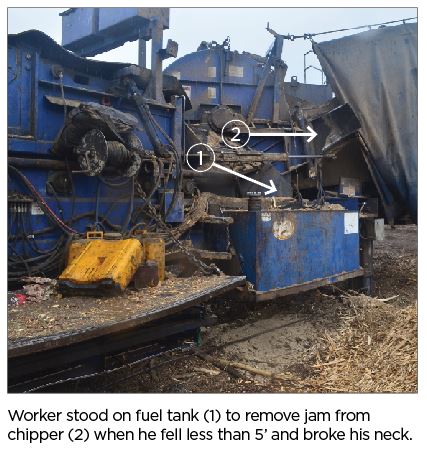Employers required to protect worker from risk of falling from any height
Hazard Alert: Worker breaks neck vertebrae after falling less than 5 feet - Download and share
What happened?
On a sunny spring day, a worker was attempting to remove a jam from the sliver chute of a whole-tree chipper. The worker was standing on a flat fuel tank pulling wood slivers from the chute when the jam unexpectedly released. As a result, the worker lost his balance, and fell backwards off the fuel tank, less than five feet to the ground, suffering fractures to the vertebrae in his neck.
Why did it happen?
Many large pieces of mobile equipment are not ideally designed for safe maintenance procedures. When performing maintenance on this type of machinery, there is a well-known risk of slipping, tripping or falling.
In this case, as is common with large pieces of equipment, there was limited access for maintenance purposes, which meant the worker had to stand awkwardly on top of the fuel tank to perform maintenance. And so, regardless of height distances, there is a significant risk of serious injury to workers falling from this unprotected location.
How could the incident have been prevented?
-
Conduct a risk assessment of the hazards, and develop safe work procedures for doing maintenance-related tasks.
-
Ensure safe maintenance methods are followed: jobs are well-planned, and the work area is cleared of debris and other slip and fall hazards.
-
When working at any height and there is potential for a fall, workers must be protected by:
-
Engineering controls: In this case, after the incident, the employer installed a guardrail system on the fuel tank to protect workers from a fall. (Note: when modifying equipment, you should ensure the manufacturer supports the modification, as well as seek engineering advice to ensure the installation meets any applicable standard and is in line with good engineering practices).
-
Fall protection equipment appropriate for the situation: This equipment prevents the worker from falling, regardless of height of work. (Note: Anyone who works at heights must be trained in the use of fall protection equipment).
-
-
Workers who are unsure of a safe way to conduct work should always consult with the supervisor.
-
Employers are legally required to provide fall protection for workers who work at heights of nine feet or more, and they are also legally required, under section 25 (2)(h) of the Occupational Health and Safety Act, to “take every precaution reasonable in the circumstances for the protection of a worker.” This also includes a known risk of falling distances less than nine feet.

